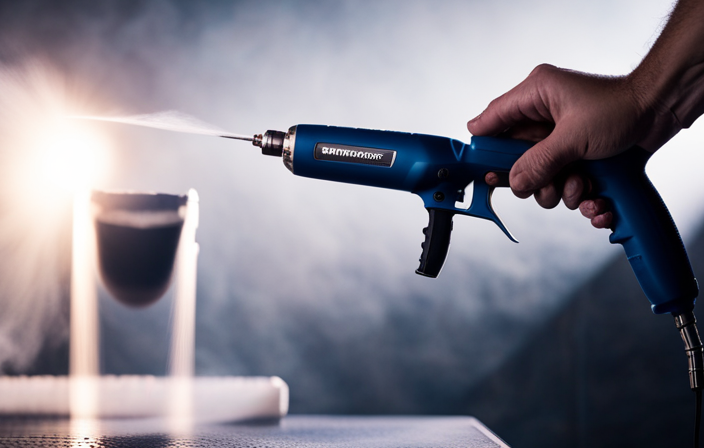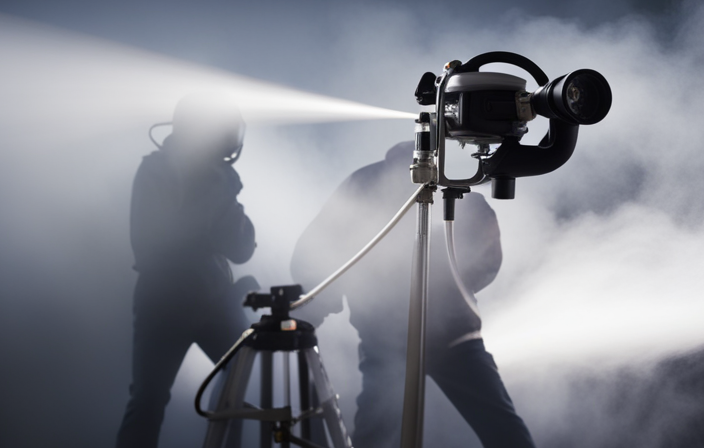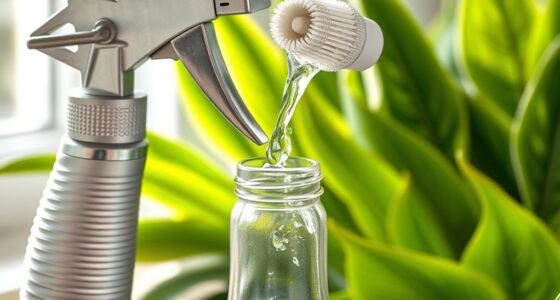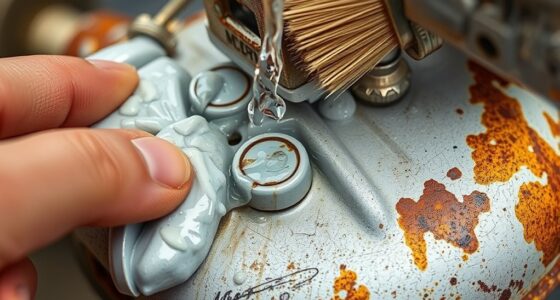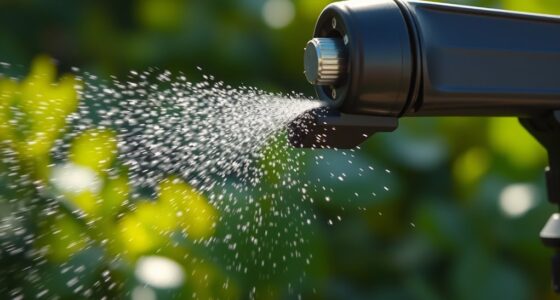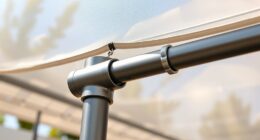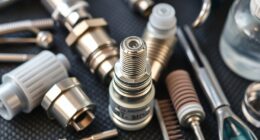I get it – cleaning an airless paint sprayer can seem like a hassle. I’ve been there myself. But trust me, with the right tools and a little know-how, it’s not as difficult as it seems.
In this article, I’ll walk you through the step-by-step process of cleaning your airless paint sprayer, ensuring that it stays in top shape and ready for your next project.
First, we’ll gather all the necessary materials, including cleaning solutions and brushes. Then, we’ll prepare the sprayer by removing any excess paint and ensuring it is properly disconnected.
Next, we’ll disassemble the components and give them a thorough cleaning, making sure to soak and rinse them to remove any paint residue.
After that, we’ll move on to cleaning the sprayer body itself, paying special attention to any clogs or blockages. We’ll then flush the system with clean water to ensure that all traces of paint are removed.
Finally, we’ll test the sprayer to make sure it’s working properly and discuss how to store it correctly.
By following these detailed instructions and maintaining a regular cleaning schedule, you’ll be able to keep your airless paint sprayer in excellent condition, ready for your next paint job. So let’s dive in and learn how to clean your airless paint sprayer like a pro.
Key Takeaways
- Proper cleaning technique is important for maintaining the performance and lifespan of an airless paint sprayer.
- Regular cleaning of the sprayer is crucial for optimal performance, as neglecting to clean it can lead to clogs, uneven spray patterns, and reduced efficiency.
- Gather the necessary materials and equipment such as cleaning solutions, brushes, bucket/container, and rags/paper towels for effective cleaning.
- Follow the cleaning process, which includes releasing pressure and removing the nozzle, emptying remaining paint from the container, disassembling and cleaning components, soaking and rinsing components, cleaning the sprayer body, reassembling the sprayer, and performing a test spray with clean water.
Gather the Necessary Materials
Now that you’ve familiarized yourself with the airless paint sprayer, it’s time to gather all the materials you’ll need for the cleaning process.
To clean your airless paint sprayer effectively, you’ll need a few essential cleaning supplies. Firstly, make sure you have a bucket or container to hold the cleaning solution. You’ll also need a cleaning brush or a soft cloth to remove any paint residue. Additionally, gather some rags or paper towels to wipe down the sprayer and absorb any excess cleaning solution.
It’s important to follow the proper cleaning technique to ensure thorough cleaning. By using the right materials and techniques, you can maintain the sprayer’s performance and prolong its lifespan.
Now, let’s move on to the next section and prepare the sprayer for cleaning.
Prepare the Sprayer for Cleaning
To prepare the airless paint sprayer for cleaning, the first step is to release the pressure and remove the nozzle. This is done by turning off the sprayer and loosening the nozzle with a wrench.
Next, empty any remaining paint from the container and dispose of it properly.
Finally, disconnect any attachments or hoses from the sprayer to ensure a thorough cleaning process.
Release pressure and remove the nozzle
First, you’ll need to release the pressure and take off the nozzle. This step is crucial to remove paint residue and prevent clogging. To release the pressure, turn off the sprayer and disconnect the power source. Then, locate the pressure relief valve and slowly open it to release any built-up pressure. Next, remove the nozzle by twisting it counterclockwise. This will allow you to access the inside of the sprayer for thorough cleaning. To help you visualize the process, here is a table outlining the steps:
| Step | Action |
|---|---|
| 1 | Turn off the sprayer and disconnect the power source |
| 2 | Locate the pressure relief valve and slowly open it |
| 3 | Twist the nozzle counterclockwise to remove it |
Now that the pressure is released and the nozzle is removed, we can move on to the next step: emptying the remaining paint from the container.
Empty remaining paint from the container
After releasing the pressure and removing the nozzle, it’s time to get rid of the remaining paint from the container, making sure not to leave even a drop.
Proper disposal of leftover paint is essential to protect the environment. To empty the container, follow these steps:
-
Prepare a clean, empty container to transfer the remaining paint.
- Place a funnel on top of the container to avoid spills.
- Make sure the container is large enough to hold all the paint.
-
Slowly pour the paint from the airless paint sprayer container into the empty container through the funnel.
- Take your time to prevent splashing or spilling.
Now that you have successfully emptied the remaining paint, it’s time to move on to the next step: disconnect any attachments or hoses.
Disconnect any attachments or hoses
Now that you’ve successfully emptied out all the remaining paint, it’s time to disconnect any attachments or hoses. Start by carefully removing any cleaning attachments, such as spray tips or filters, from the airless paint sprayer. These attachments can accumulate paint residue, so it’s important to clean them separately.
Next, detach the hoses from both the sprayer and the paint container. Gently twist and pull the hoses to disconnect them, being cautious not to damage any of the components. Once detached, inspect the hoses for any clogs or buildup and clean them thoroughly if necessary. This step is crucial to ensure that your airless paint sprayer functions properly and delivers a clean spray.
With the attachments and hoses disconnected, we can now move on to the next section and learn how to disassemble and clean the components.
Disassemble and Clean the Components
To properly maintain your airless paint sprayer, it is imperative to dismantle and cleanse its various components. Disassembling the sprayer allows for a thorough cleaning, ensuring optimal performance for your next paint job. Here are some disassembling tips and effective cleaning methods to follow:
| Component | Cleaning Method |
|---|---|
| Spray Gun | Remove the nozzle and filter, clean with warm soapy water, and use a brush to remove any clogs or debris. |
| Pump Assembly | Disconnect the pump from the motor, clean the intake valve and filter with a solvent, and inspect for any damage or wear. |
| Hose | Disconnect the hose from the sprayer, flush it with clean water to remove any paint residue, and inspect for any leaks or cracks. |
| Pressure Control Knob | Remove the knob and clean it with a mild detergent, making sure to remove any paint buildup or debris. |
Once all the components are disassembled and cleaned, it’s time to move on to the next step: soak and rinse the components.
Soak and Rinse the Components
Don’t forget to give your components a good soak and rinse to ensure they’re ready for your next project! Soaking the components in a cleaning solution can help break down any residual paint or debris that may be stuck.
However, it’s important to consider the pros and cons of using cleaning solutions. While they can be effective in removing stubborn stains, they may also contain harsh chemicals that can be harmful to your health or damage the components. If you choose to use a cleaning solution, make sure to follow the manufacturer’s instructions and wear protective gloves and goggles.
After soaking, rinse the components thoroughly with clean water to remove any remaining cleaning solution. This step is crucial to ensure that no residue is left behind, as it can affect the performance of the paint sprayer.
Once the components are rinsed, it’s time to dry them effectively. To speed up the drying process, you can use a clean cloth or towel to gently pat them dry. Alternatively, you can let them air dry naturally, but this may take longer.
Now that the components are clean and dry, it’s time to move on to the next step: cleaning the sprayer body.
Clean the Sprayer Body
The heart of your painting arsenal, the sprayer body, deserves some TLC to keep it performing at its peak. To clean the sprayer body, you’ll need a cleaning solution specifically designed for airless paint sprayers. Before you start, remember to take proper safety precautions such as wearing gloves and safety goggles.
Here’s a quick and easy way to clean the sprayer body:
- Begin by disconnecting the sprayer from the power source and removing the nozzle and filters.
- Wipe down the exterior of the sprayer body with a clean cloth dampened with the cleaning solution.
- Use a small brush or toothbrush to scrub away any dried paint or debris from the body.
- Rinse the body thoroughly with water to remove any remaining cleaning solution.
Once the sprayer body is clean, it’s time to reassemble the sprayer and get ready for your next painting project.
Reassemble the Sprayer
Once you’ve finished cleaning, it’s time to put all the pieces of the sprayer back together and get ready for your next painting adventure. Reassembling the sprayer may seem daunting, but with the right techniques, it can be a breeze. Start by referring to the manual for specific instructions on how to reassemble each component. Make sure to align the parts correctly and securely tighten any screws or fittings. To ensure a smooth operation, lubricate any moving parts with the recommended oil or grease. If you encounter any difficulties, consult troubleshooting tips in the manual or contact customer support for assistance. Remember, a properly reassembled sprayer is crucial for achieving optimal painting results. Now, let’s move on to the next section and learn how to flush the system for a clean start.
Flush the System
To flush the system of an airless paint sprayer, I first fill the sprayer with clean water. Then, I connect the sprayer to a water source, ensuring a steady flow. Finally, I flush the system by spraying water through the nozzle, effectively removing any remaining paint or residue.
Fill the sprayer with clean water
Start by filling the sprayer with fresh, clean water. This is an important step in cleaning your airless paint sprayer as it helps to flush out any remaining paint or residue.
Here are some cleaning solution options you can use with the water:
- Vinegar and water mixture: This is a natural cleaning solution that helps to remove any built-up paint or debris.
- Bleach and water mixture: This solution is effective in killing any bacteria or mold that may have formed in the sprayer.
- Commercial paint sprayer cleaner: These cleaners are specifically designed to remove paint and clean the inside of the sprayer.
- Warm soapy water: This is a simple and effective solution for cleaning the sprayer.
Regularly cleaning your sprayer is crucial to maintain its performance and prolong its lifespan.
Once the sprayer is filled with water, you can then proceed to connect it to a water source for further cleaning.
Connect the sprayer to a water source
After filling the sprayer with water, it is important to connect it to a water source in order to effectively clean and maintain its performance. Did you know that regularly cleaning your sprayer can increase its lifespan by up to 50%? To ensure proper connectivity, follow these steps:
| Step | Action |
|---|---|
| 1 | Check the water source connection for any leaks or damages. |
| 2 | Attach the sprayer’s inlet hose to the water source using a secure connector. |
| 3 | Turn on the water source and adjust the water pressure control knob on the sprayer for optimal cleaning. |
Connecting your sprayer to a water source may resolve any connectivity issues and allow for an efficient cleaning process. Controlling the water pressure ensures thorough cleaning without causing damage to the sprayer. Once connected, you can proceed to the next step of flushing the system by spraying water through the nozzle.
Flush the system by spraying water through the nozzle
Now, let’s give your sprayer a refreshing cleanse by spraying water through the nozzle and rejuvenating its performance.
Flushing the system is an essential step in cleaning your airless paint sprayer and ensuring its longevity. To start, attach the sprayer to a water source, making sure the water pressure is set to the lowest setting.
Next, hold a bucket or container under the nozzle to catch the water that will be expelled. Activate the sprayer and spray water through the nozzle for a few minutes, allowing any leftover paint or debris to be flushed out.
If you notice any clogs or inconsistencies in the spray pattern, try adjusting the pressure or cleaning the nozzle with a small brush. Now, you’re ready to move on to the next step and test the sprayer’s functionality.
Test the Sprayer
First, you’ll want to grab a piece of scrap material to test the airless paint sprayer and make sure it’s working properly. This step is crucial to test the accuracy of the sprayer and troubleshoot any potential issues.
Connect the sprayer to the paint container and turn it on. Slowly squeeze the trigger to allow the paint to flow through the nozzle. Observe the spray pattern and make sure it’s even and consistent. Check for any clogs or irregularities in the spray.
If the sprayer isn’t working correctly, consult the user manual or contact the manufacturer for troubleshooting tips.
Once you’ve confirmed that the sprayer is functioning properly, you can move on to the next section on how to store the sprayer properly.
Store the Sprayer Properly
To ensure your sprayer remains in perfect condition for future use, it’s crucial to securely store it, preserving its power like a hidden treasure waiting to be unleashed. Proper storage is essential in preventing clogs and maintaining the efficiency of your airless paint sprayer. Here are some tips for storing your sprayer properly:
-
Clean the sprayer thoroughly: Before storing, make sure to clean the sprayer according to the manufacturer’s instructions. Remove any excess paint and clean all the components to prevent buildup and clogs.
-
Disassemble and organize: Take apart the sprayer and organize all the parts in a secure and labeled container. This will help you easily locate and assemble the sprayer when you need it again.
-
Store in a cool and dry place: Find a cool and dry place to store the sprayer. Avoid extreme temperatures and humidity, as they can damage the sprayer over time.
By following these proper storage techniques, you can ensure that your sprayer remains in optimal condition. In the next section, we will discuss how to maintain a regular cleaning schedule to further extend the life of your airless paint sprayer.
Maintain Regular Cleaning Schedule
Maintaining a regular cleaning schedule for my airless paint sprayer is crucial in ensuring its optimal performance. After each use, I make it a point to thoroughly clean the sprayer, removing any paint residue or debris that may have accumulated.
Additionally, regularly inspecting and replacing worn or damaged parts is essential to prevent any potential issues or malfunctions. I always adhere to the manufacturer’s instructions for maintenance, as they provide valuable guidance on how to properly care for and extend the lifespan of my sprayer.
Clean the sprayer after each use
After using the airless paint sprayer, make sure to clean it thoroughly. This is essential to maintain the sprayer’s performance and longevity.
Start by disconnecting the sprayer from the power source and relieving any pressure in the system. Then, disassemble the spray gun, nozzle, and filters. Use a suitable cleaning solution to remove any paint residue, ensuring all parts are thoroughly cleaned. Rinse them with water and allow them to dry completely before reassembling.
Pay attention to the filters and replace them if necessary. Regularly inspect and replace worn or damaged parts to ensure optimal functionality.
By following these cleaning and maintenance steps, you can keep your airless paint sprayer in excellent condition for future use.
Next, let’s discuss how to regularly inspect and replace worn or damaged parts.
Regularly inspect and replace worn or damaged parts
Regularly checking for signs of wear or damage is crucial for ensuring the longevity and optimal functionality of your sprayer.
Inspecting worn parts, such as the nozzle, seals, and hoses, is essential to identify any potential issues that may affect the performance of your airless paint sprayer.
Worn or damaged parts can lead to leaks, uneven spray patterns, or even complete breakdown of the sprayer.
If you notice any signs of wear or damage, it’s important to promptly replace the affected parts to maintain the efficiency of your sprayer.
By taking the time to regularly inspect and replace worn or damaged parts, you can avoid costly repairs and ensure that your sprayer continues to deliver professional-quality results.
Following the manufacturer’s instructions for maintenance will further enhance the performance and longevity of your airless paint sprayer.
Follow manufacturer’s instructions for maintenance
By adhering to the guidelines provided by the manufacturer, you can ensure that your sprayer remains in optimal condition for long-term use. Following the manufacturer’s instructions for maintenance is crucial to keep your airless paint sprayer working efficiently. Regular maintenance will not only extend the lifespan of your sprayer but also improve its overall performance.
Here are some essential maintenance tips to follow. Firstly, clean the sprayer thoroughly after each use to prevent any buildup or clogs. Secondly, inspect the filters and replace them if they’re worn or damaged. Additionally, regularly check the spray tip for any wear and tear and replace it if necessary.
Lastly, familiarize yourself with troubleshooting techniques provided by the manufacturer to address any issues that may arise during operation. By following these maintenance tips and troubleshooting techniques, you can ensure that your airless paint sprayer continues to deliver optimal results.
Frequently Asked Questions
How often should I clean my airless paint sprayer?
I recommend replacing the filters in your airless paint sprayer every 6-12 months to ensure optimal performance. Regularly cleaning your sprayer removes clogs and debris, leading to smoother paint application and a longer lifespan for your equipment.
Can I use any type of cleaning solution for the components?
Yes, you can use different types of cleaning solutions for the components of your airless paint sprayer. However, it is important to follow best practices for cleaning solution disposal to ensure proper safety and environmental protection.
Is it necessary to disassemble the components before cleaning?
Before cleaning, it’s crucial to disassemble airless paint sprayer components. This step ensures proper maintenance and efficient cleaning. By taking apart the parts, you can thoroughly remove paint residue and debris, ensuring optimal performance and longevity of the sprayer.
How long should I soak the components in the cleaning solution?
I recommend soaking the components in a suitable cleaning solution for at least 30 minutes. The soaking time allows the solution to effectively break down any paint residue. Make sure to use a cleaning solution specifically designed for airless paint sprayers.
Can I use a pressure washer to clean the sprayer body?
Using a pressure washer for sprayer cleaning is not recommended as it can damage the delicate components. Instead, opt for alternative cleaning methods such as using a brush, cloth, or a mild cleaning solution.
Conclusion
In conclusion, keeping your airless paint sprayer clean is crucial for its optimal performance. By following the steps outlined in this article, you can ensure that your sprayer remains in top shape and continues to deliver professional-quality results.
Remember, a clean sprayer is like a breath of fresh air for your painting projects, allowing you to breeze through them with ease. So don’t neglect the maintenance of your sprayer and enjoy the smooth and efficient painting experience it provides.
Keep painting, keep shining!
